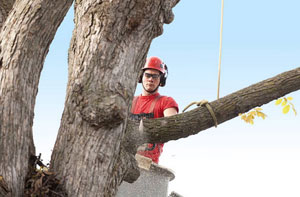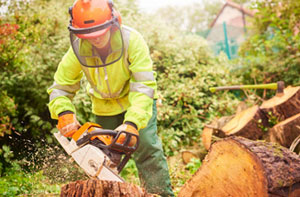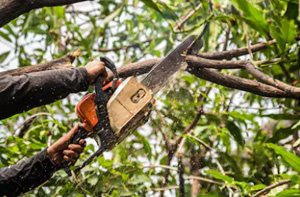Leighton Buzzard Tree Surgeon Bedfordshire: A vital feature of many gardens and properties in Leighton Buzzard, trees add style, structure and substance to what can quite often be an unexciting and 2 dimensional landscape. But issues can develop when trees are neglected or have been impacted by extreme weather conditions, for example flooding or gales. If your trees need attention, the safest option is to consult an experienced tree surgeon in Leighton Buzzard, for their guidance before any work starts.
Those in Leighton Buzzard who attempt to do tree work by themselves, or by using non-qualified personnel could cause a risk of damage to property, the trees or to life. However, even for certified tree surgeons who are aware of all the hazards, tree work is not entirely safe. Tree surgery is definitely not a job for amateurs, and on average there are 3 deaths and 140 major injuries a year within the industry, making it one of the most hazardous jobs in the United Kingdom.

A neglected or damaged tree can also pose a threat to life, with around 5 people annually being killed by falling trees and branches in Britain. If you employ someone to conduct tree work and property is damaged, or an injury occurs, you may be liable to third-party compensation claims. The above are just a few of the reasons why it is important to retain the services of a certified tree surgeon to carry out the work on your trees. (All figures from HSE).
A competent tree surgeon in Leighton Buzzard will likely be a member of at least one of the two major professional arboricultural bodies. The membership and professional status of any tree surgeon in Leighton Buzzard can be checked out on the websites of both the ISA (International Society of Arboriculture) and the AA (Arboricultural Association). To determine whether any particular local tree surgeon has recognised Approved ARB Contractor status and has membership of either of these two associations, you can check on this page.
You will be able to get in touch with these trade bodies for mediation and for help and advice, if there's an issue at any stage during the course of the tree work, or after it has been concluded.

You shouldn't be frightened to politely decline the offer of an estimate from somebody who is not on this directory list, since at the end of the day, it's an approved contractor that you should be looking for. It's best to get at least three quotations from different companies in the Leighton Buzzard area, once you have thoroughly checked their professional qualifications and memberships. Because of the risks of the work involved, you should ask the following questions, making it clear that you need a response:
- Do you supply quotations in writing? Always get a quote in writing, and NEVER accept a quote that's only given verbally.
- Can you show documentary evidence of your qualifications, professional membership and a NPTC certificate for the use of a chainsaw? Any operative/tree surgeon who uses a chainsaw, must by law have a NPTC/LANTRA certificate. Qualifications can include Certificates and National Diplomas in Arboriculture.
- Could I contact some past customers to check the quality of your workmanship? It is generally advisable to carry out an independent check on recently completed work.
- What level of insurance coverage do you have? Your tree surgeon ought to be able to produce an insurance certificate covering at the least £5 Million public liability, as recommended by the ISA and AA.
The written quote that you're given must include clear and precise details about the planned work. Who's responsible for the removal and disposal of waste, tree branches and stumps should be stated, as should details of any trees which could be protected, and the steps required to get permission to work on them. Double check that they have also included VAT on the quote. Understanding that you have a responsibility for hiring only competent people to work on your property and trees, is important. This is stated under the "Common law duty of care responsibilities and sometimes liabilities under the Occupier's Liability Acts of 1957 and 1984."
PRIOR TO WORK COMMENCING - Your preferred Leighton Buzzard tree surgeon should enquire whether any of your trees are protected and take the appropriate steps to ensure that any tree work can be given the green light from the local authorities. Discovering that a tree has got protected status doesn't imply that work can't be carried out, as even protected trees need to be maintained so as to cut back old or damaged wood and ensure public safety.
If your property in Leighton Buzzard is located in a designated conservation area then at least six weeks written notice is required to the Local Planning Authority before any tree work can be carried out. This is only applicable to trees with a trunk diameter of more than seventy five millimetres in diameter, at a point 1.5 metres above ground level. If the thinning or pruning of a protected tree's branches are required in order to sustain and promote growth, written notice is also not necessary.

After doing a full assessment of your trees health, your chosen Leighton Buzzard tree surgeon will decide on the remedial treatment needed and how best and safely to achieve the required outcome. Where there is any possibility of falling debris and branches, a full risk assessment will have to be done on your property, public areas, and sections of a neighbour's property that may be affected. This stage will also establish the amount of operatives required and the level of protection needed. To keep property and the general public safe from harm or damage, this will include both personal protective equipment (PPE) and other safety precautions.
ON THE DAY OF WORK - To keep unauthorised persons and passers-by away from the area of work, safety measures and barriers should be put in place before any cutting of branches, climbing or tree felling begins. Traffic might need to be stopped temporarily if there is a threat of falling debris into a public highway.
According to the type of work that's required a tree surgeon will need varying degrees of protection. At the very least they will be wearing protective clothing to prevent serious cutting injuries to the hands, legs and torso, when doing chainsaw work. High visibility clothing, and head and eye protection, should be worn by all workers involved in the operation.
Climbing equipment and ladders will need to be deployed if any working at height is involved, and to help in the safe removal of high branches and pieces of tree trunk, additional operatives will be necessary. For the removal of waste, easy access to the work site will be necessary. Therefore, it's recommended that you inform your neighbours, as a pickup truck or skip will need to be parked as close as possible to the work area while the work proceeds.
UPON COMPLETION OF WORK - All of the waste materials will be transported away and the site cleared of all debris, when all tree work has been concluded. Your tree surgeon should then sign off and provide you with a certificate of work done, especially where the trees are covered by TPOs. Any safety measures that were put in public spaces can then be removed, with highways and footpaths being re-opened.
If you've got any complaints about or issues with the work, you should get them fixed immediately by firstly speaking to the tree surgeon. If your tree surgeon is a signed up member of a professional trade association, and any further arbitration is required, you can receive advice and guidance from the Arboricultural Association or the International Society of Arboriculture in order to arrive at an acceptable solution.
Local Leighton Buzzard tree surgeons will probably have the telephone dialling code 01525 and the postcode LU7. They'll work in Leighton Buzzard itself, along with nearby areas like Stanbridge, Heath and Reach, Linslade, Battlesden, Stewkley, Eaton Bray, Billington, Soulbury, Little Brickhill, Hockliffe, Mentmore, Great Brickhill, Milton Bryant, Slapton, and these postcodes: LU7 1DG, LU7 1DL, LU7 1SP, LU7 1JD, LU7 1EA, LU7 1BS, LU7 1JH, LU7 1FG, LU7 1FH, LU7 1BF.
If you require this sort of assistance it is definitely far better to employ a qualified tree surgeon. Leighton Buzzard home and property owners can benefit from the expertise and knowledge that are the trademark of a fully trained professional.
Dutch Elm Disease
Although Dutch Elm Disease (Ophiostoma novo-ulmi) is not quite the issue that is was previously, during the last fifty years or more it has killed off millions of precious elm trees all over Great Britain. Unintentionally imported into Britain from Canada in the late 1960s, DED (Dutch Elm Disease) is spread by the elm bark beetle and caused by the Ophiostoma novo-ulmi fungus.
Through the transportation of elm products like elm crates, saplings, bark mulch, and firewood logs with the bark still attached, it spread rapidly through the United Kingdom after its initial arrival. Dutch Elm Disease didn't only affect the UK, but also decimated elm stocks in mainland Europe, North America and New Zealand, it is thought to have originated in Asia (probably Japan).
DED generally first materializes in early summer, and the main signs are:
- Twigs turning into a "shepherd's crook".
- New shoots that die back from the tips.
- Clusters of leaves that turn yellow, wilt and fall.
- Dark streaks under the bark of twigs.
Because there are now very few sizeable elms in the UK countryside, the elm bark beetle's favourite habitat has been pretty much eradicated, the result of which has been a slowing down of Dutch Elm Disease. The propagation of young elms that are resistant to DED is an ongoing project.
If you have suspicions that you might have infected elm trees in your garden in Leighton Buzzard, you could put in a request for a diagnosis from the THDAS (Tree Health Diagnostic and Advisory Service), or get hold of your local tree surgeon for advice.
Trees affected - Ulmus and Zelkova.
Vectors - small beetles of the Scolytus genera.
Cause - fungi Ophiostoma Ulmi and Ophiostoma Novo-Ulmi.
(Tags: Spotting Dutch Elm Disease, Signs of Dutch Elm Disease, Dutch Elm Disease Leighton Buzzard).Accidents Through Tree Surgery
As has been previously mentioned on this page, the work that is tackled by tree surgeons and tree care professionals in Leighton Buzzard can be highly hazardous. With a high risk of injury to both operatives and passers-by, all reasonable safety measures should be taken when carrying out work on trees.
It would appear (as stated by the HSE (Health and Safety Executive)), that falls from trees, the use of chainsaws, and being hit by a falling branch or tree are responsible for the majority of serious and fatal injuries that are associated with tree work. In fact, operatives that are involved in tree care work are more at risk of serious injury than those involved in building and construction.
The most common tree surgery accidents are lifting injuries, being struck by objects (grapple hooks, ropes, cranes, branches, trees etc) and falling from ladders, with regards to insurance claims.
That is why hiring a competent Leighton Buzzard tree surgeon is so important when you have tree work that needs to be done. In the tree care industry, many accidents are down to inexperienced workers attempting tasks that they are not fully trained in, or equipped for. Using a trustworthy and established company that has been trading in the Leighton Buzzard area for a good few years, is the best way to avoid such problems, and get your tree surgery work done in the safest possible way.
Woodland Clearance Leighton Buzzard

The clearance of woodlands in the Leighton Buzzard area is a sophisticated process that can be affected by a number of regulations and restrictions. A qualified tree surgeon in Leighton Buzzard can offer an all-encompassing service that will observe all laws and covenants on the land, and will also complete the project an eco-friendly way.
A reliable company will liaise with local and national woodland authorities and organisations to carry out an extensive survey of the site. Mitigation procedures may need to be employed if there's protected vegetation or animal species on site; this could call for replanting of trees and relocation of animals, such as lizards or bats to an alternative protected site.
It will be much more economical to call on an accredited Leighton Buzzard tree care company to carry out your clearance work, as the mulching, chipping and felling equipment that is required is extremely pricey.
Ash Dieback (Hymenoscyphus Fraxineus)
Likely to decimate approximately eighty percent of the current British ash trees, over the next few years, ash dieback is a highly infectious fungal disease of ash trees that was first recorded in the United Kingdom in 2012. Already having an equally calamitous impact on the British countryside as Dutch Elm Disease (DED), ash dieback is just another blow to the UK's tree stocks.
A disease which affects the Fraxinus genus of trees, it has an especially disastrous effect on Fraxinus excelsior, the native British common ash. Originating in Asia where the native Chinese ash (Fraxinus chinensis) and Manchurian ash (Fraxinus mandshurica) are less seriously affected by it, the fungus which causes the disease is called Hymenoscyphus fraxineus, and it kills a tree by blocking its water transport (vascular) systems.
Now present in most parts of Britain, ash dieback (or chalara ash dieback) is dispersed by tiny spores that blow on the wind, and which are able to travel for many miles.
Ash dieback has an effect on trees of every age group and has the following symptoms:
- Dying shoots and leaves are visible in summer.
- Dark brown lesions form where limbs join the trunk, and the inner bark under the lesions looks brownish grey.
- Dark patches on leaves during mid to late summer.
- New epicormic growth appearing from previously dormant buds (common in trees under stress).
- Leaves that wilt, turn black and fall prematurely.
To a certain degree, ash trees are able to fend off the infection, however they eventually succumb as they are continually attacked year-on-year. There is not yet any cure or effective treatment for ash dieback, and because it is an airborne disease, no effective way of stopping it spreading.
If you believe a tree in your local area is contaminated with ash dieback, or you are anxious about a tree in your garden in Leighton Buzzard, you should bring in a local tree surgeon to confirm the diagnosis, and you can report it to the Forestry Commission's "Tree Alert Service", although they are currently only interested in cases in areas that were previously unaffected.
Trees of the genus Fraxinus are affected.
Tree Surveys Leighton Buzzard
There are a number of reasons why you could need to have a tree survey carried out, and the most common is for development or property extension. If you're clearing a piece of land in Leighton Buzzard that has trees on it, to make way for a new house or an extension to an existing property, you will need to conduct a professional tree survey as laid out by the British Standards BS5837. Tree surveys on both public and private property in Leighton Buzzard, must be handled by an accredited tree surgeon or tree surveyor.
A broad range of information will be produced about all of the trees within the specified area. For instance:
- Guidelines for tree management.
- A unique reference number for each tree.
- The predicted life expectancy of the trees.
- The height of each tree.
- The health of the trees.
- The diameter of each tree (taken 1.5m above ground level).
- The species of trees.
- The ages of the trees (i.e. young, semi-mature, mature, over-mature and veteran).
- The number of trees (those of over 75mm diameter 1.5m from ground level).
- The spread of branches to East, South, North and West.
- The existence of any Tree Preservation Orders (TPOs).
You will probably not need to carry out a tree survey if you happen to be altering an existing property in Leighton Buzzard but you are not extending the building's footprint and are not shifting the service lines or access points.
Regular Duties of a Tree Surgeon
- Be adept with power tools and powered machinery.
- Maintain and service equipment like chainsaws and wood chippers.
- Tree planting and transplanting.
- Deal with clients and complete administrative duties.
- Produce tree survey reports for both domestic and commercial customers.
- Fell and remove trees and perform stump grinding.
- Identify hazards presented by trees.
- Tidy up work area upon completion and fulfil removal of waste product from client's site.
- Create telephone or on-site price quotes for clients.
- Cut and chip logs and branches.
- Assess the health of trees and create plan of action.
- Climb trees to prune or remove branches as required.
Tree Surgery Tasks Leighton Buzzard

Leighton Buzzard tree surgeons will likely help with arboriculture, stump removal, health assessments, retrenchment pruning, tree topping, site clearance in Leighton Buzzard, stump grinding, crown reduction, cut sealing Leighton Buzzard, tree pest management, tree care services Leighton Buzzard, coppicing Leighton Buzzard, pollarding, stump treatment, eco plug treatments, crown cleaning, hedge lowering, hedge laying, safety inspections, the removal of dead wood, tree replanting in Leighton Buzzard, root flare exposure Leighton Buzzard, crown raising, tree planning, the protection of trees from grazing animals, residential tree surgery, tree waste removal in Leighton Buzzard, tree pruning, root pruning in Leighton Buzzard, tree reduction Leighton Buzzard and other tree surgeon services in Leighton Buzzard, Bedfordshire. Listed are just a few of the activities that are conducted by a tree surgeon. Leighton Buzzard specialists will inform you of their entire range of services.
Tree Surgeons Nearby
Also find: Eaton Bray tree surgeon, Stewkley tree surgeon, Milton Bryant tree surgeon, Great Brickhill tree surgeon, Little Brickhill tree surgeon, Soulbury tree surgeon, Billington tree surgeon, Battlesden tree surgeon, Slapton tree surgeon, Linslade tree surgeon, Mentmore tree surgeon, Heath and Reach tree surgeon, Hockliffe tree surgeon, Stanbridge tree surgeon and more. Most of these villages and towns are served by tree surgeons. Business and home owners in the area can acquire tree surgery quotes by going here.
Tree Care Services Leighton Buzzard
- Leighton Buzzard Tree Care
- Leighton Buzzard Tree Management
- Leighton Buzzard Tree Watering
- Leighton Buzzard Tree Removal
- Leighton Buzzard Stump Removal
- Leighton Buzzard Crown Removal
- Leighton Buzzard Woodland Management
- Leighton Buzzard Tree Reduction
- Leighton Buzzard Hedge Planting
- Leighton Buzzard Stump Grinding
- Leighton Buzzard Tree Shaping
- Leighton Buzzard Tree Maintenance
- Leighton Buzzard Tree Planning
- Leighton Buzzard Stump Treatment
 Tree Surgeon Leighton Buzzard
Tree Surgeon Leighton Buzzard Tree Surgeons Leighton Buzzard
Tree Surgeons Leighton Buzzard Tree Surgery Leighton Buzzard
Tree Surgery Leighton BuzzardLeighton Buzzard Beds (Bedfordshire): The town of Leighton Buzzard can be found in the Eastern district of England in the county of Bedfordshire. Leighton Buzzard is approximately 12 miles from Milton Keynes and 14 miles from Luton, towns and villages nearby include Hockliffe, Milton Bryant, Little Brickhill, Stewkley, Slapton, Soulbury, Billington and Heath and Reach. Leighton Buzzard has a population of about 37,000, has the telephone dial code 01525 and is in the postcode district LU7. Leighton Buzzard and the adjoining town of Linslade sit to the north of the Chiltern Hills near to the border between Bedfordshire and Buckinghamshire. (Tags: Leighton Buzzard UK, Leighton Buzzard Beds, Leighton Buzzard England, Leighton Buzzard Bedfordshire)
Tree Surgery LU7 area, (dialling code 01525).
TOP - Tree Surgeon Leighton Buzzard
Tree Surgeons Leighton Buzzard - Arboriculture Leighton Buzzard - Tree Management Leighton Buzzard - Tree Felling Leighton Buzzard - Tree Surgeon Leighton Buzzard - Vegetation Management Leighton Buzzard - 01525 - Forest Management Leighton Buzzard - LU7





